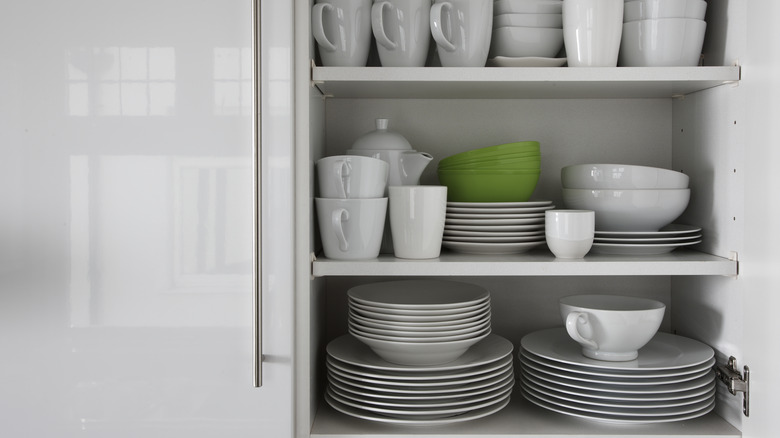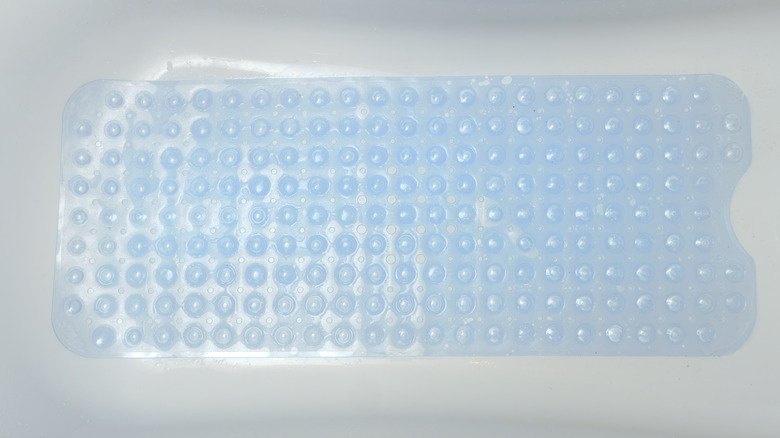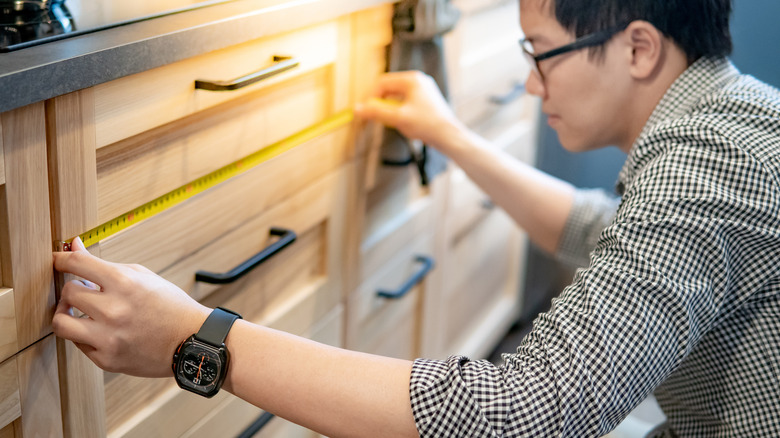The Unexpected Way You Should Be Using A Shower Mat In The Kitchen
We may receive a commission on purchases made from links.
What's the result of not using shelf liners in your pantry or kitchen drawers? Chipped mugs, scratched dinner plates, and pricey wine glasses in pieces. Your wallet takes a hit when you have to buy new dinnerware. Chipped dishes are not worth keeping — they can harbor nasty germs that endanger your family's health. Shelf liners keep your dishes from clunking together, but they can be expensive for high-quality options (and you don't want to bother with low-quality liners). The answer? Use a non-slip bathmat instead. You know, those ones you put inside the shower stall or tub to stop you from slipping over when getting in or out. They're more durable, easy to modify, and often cheaper than their purpose-made counterparts.
Shelf liners are on the thinner side to increase their pliability; shower mats, on the other hand, are designed for stability and comfort, so they tend to be thicker. Not only will a thicker mat potentially stand up better to rough handling, making replacing it less often a money-saving possibility, but it'll also provide more cushioning for the dinnerware you inherited from your grandmother and those handmade XL mugs. They're also arguably more non-stick than shelf liners — after all, they're made to stop a literal adult person from slipping over! The low-profile ridges and bumps built into the surface of the mats also contribute to their hefty grip-ability, ensuring your glass tumblers stay where you put them.
Buying bath mats for your pantry
First, make sure you buy non-slip bath mats without suction cups — suction cups will create an uneven surface for your dishware to sit on. Then, consider the material the mat is made of since they're not designed to be used with tableware. If you're worried about issues like the release of VOCs from plastic or PFAS and BPA contamination, look for bathmats made from organic materials, like natural rubber or latex. For example, Earthsake sells a small natural latex mat with low-profile suction cups for $19.95, at the time of writing. Meanwhile, Amazon has an extra-long Bligli mat (without suction cups) for $25.99. Bonus: It's machine washable!
However, while there's increasing evidence that plastic food containers pose a contamination risk, there's no evidence to suggest that storing dishware on plastic is a health issue. If money is a concern, budget non-slip bathmats should work just fine. Dollar Tree's 25x13-inch clear PVC bath mat will set you back just $1.25, or get a loofah-textured, mildew-resistant mat with no suction cups for $13.99 at Walmart. Since heating the plastic (not a problem here) and wear and tear are the main health culprits, especially where microplastics are concerned, just be sure to change your mats when they show signs of deterioration. We also don't recommend upcycling a used tub mat for ... obvious reasons.
Measure, cut, fit, and arrange
Measure the shelves or drawers you wish to line to determine what size and how many non-slip shower mats you need to purchase. You'll avoid wastage this way. These mats typically measure 25x16 inches, but smaller and larger options are available. Cut the mat (or mats) as needed to make them fit perfectly — use the sharpest scissors you have or even a box cutter to ensure clean edges. Clean the shelf or inside of the drawer with an all-purpose spray and a cleaning cloth. Then, fit your makeshift liner to the surface, smoothing out any wrinkles with your hand. It should stick a little when tugged. If there's any overhang, trim it off with the aforementioned scissors or box cutter and refit the mat.
Arrange your items from tallest at the back to shortest at the front. This will help you see what you have at a glance, make things easier to get out when you need them, and, if anything should topple, say, when your grumpy teen tugs on that drawer pull a bit harder than necessary, they won't have far to fall. Aesthetically, these mats work best in interior draws where they can't be seen, but if you buy clear mats or favor practicality over appearance, they can be used on open shelving, too. When the dishes are said (washed?) and done, there's no denying you should be using shelf liners in your kitchen cabinets; what you use is up for creative interpretation.


